

JIM's 1942 BSA WM20 - Mission Impossible? 
Twenty years as a winch
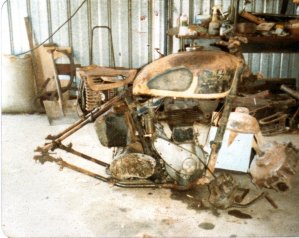
2005
In 2005 Jim purchased this collection of WM20 parts. The history of the bike is interesting. Presumably it did service during WW2 in the Australian armed forces and after the war it spent at least 20 years in a cave on the beach being used as a winch to pull a fisherman's boat out of the water. A friend rescued it from the cave and years later sold it to Jim. The bike had no wheels, no girder forks, no tinware and lots of rust. Now that is challenge too hard to resist! Jim has decided to restore the bike to "civilian trim" as most WM20s found themselves treated to black paintwork at the end of the war. |
Early 2006
The engine is completely stripped down and found to be badly worn - as expected. New main bearings are puchased and fitted and the flywheel is sent off to Tim (our local whiz!) for new rollers. Tim finally arranges a rebore, new piston and rings, new valve guides, valves, valve springs and anything else that needs to be renewed. |
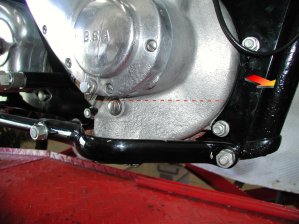 Early 2006 Early 2006
The frame and cycle parts are sent off for two-pack painting while the search begins for the missing parts. The bottom frame member (quite a sizable lump of the M20 frame) is found to be badly rusted - too badly rusted to use. Further investigation finds that the bottom of the bike was regularly immersed in a few inches of seawater during its life as a winch! A new frame meber is located and the photo on the left clearly shows the corroding on the crankcase and the pitting on the front downtube. The downtube, whilst pitted, is still in good solid condition and will make an excellent talking point!
|
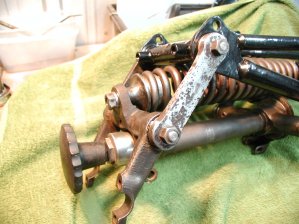 |
September 2006
The girder forks have been quite a saga. After attending every swap meet (autojumble), advertising and generally asking around amongst the local restorers, Jim has come up with enough bits to fashion into a set of girders. Leon has assisted Jim by rebushing the old very worn girders and machining new spindles. After scouting around for some more pieces finally the girders are complete. To anyone contemplating an M20 restoration without girders - keep in mind that it took Jim almost a year to find a complete set.
|
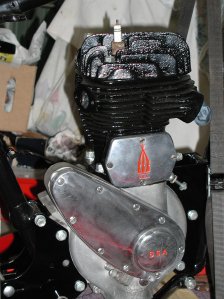 |
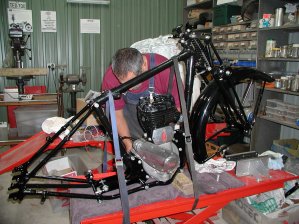 |
December 2006 (above)
Finally the motor is finished, polished and painted. The refurbished girders have been to the painter and are ready to fit to the machine. Jim has found a supplier who has imported new pattern mudguards for the M20. They fit well and look great once painted with glossy two-pack black. Jim has made all the mudguard stays with tubing and a jig he has fashioned to put the correct flat crimp on the end.The engine is fitted into the frame and suddenly it is starting to look like a bike. Note that most of the fasteners have been bright zinc plated using a home plating kit. This has proved to be very successful although considerable cleaning work is required on the wire brush in order to get good results. Wear safety glasses! |
| |
|






